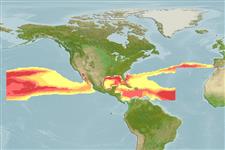>
Lophiiformes (Anglerfishes) >
Oneirodidae (Dreamers)
Etymology: Oneirodes: Greek, 'oneiros' = a dream or dreamlike or out of a dream (suggesting this fish is so strange and marvelous that can exist only in dreams) (Ref. 86949).
More on authors: Regan & Trewavas.
Environment: milieu / climate zone / depth range / distribution range
Écologie
marin bathypélagique; profondeur 0 - 1000 m (Ref. 86949). Deep-water; 40°N - 10°N
Eastern Central Atlantic: Off Azores. Western Central Atlantic: Caribbean Sea. Eastern Central Pacific: Off Hawaii.
Taille / Poids / Âge
Maturity: Lm ? range ? - ? cm
Max length : 2.7 cm SL (female)
Description synthétique
Clés d'identification | Morphologie | Morphométrie
Rayons mous dorsaux (Total) : 5; Rayons mous anaux: 4. Characterized by having escal morphology: esca with anterior appendage short and stout, not longer than escal bulb, bearing a fringe of filaments on lateral margin near base and a single unbranched filament on anterior margin; stout, forked medial escal appendage, more than three times length of escal bulb, bearing 4-5nshort branches near base; left fork of medial appendage with 2 relatively short branches; unbranched fingerlike posterior escal appendage shorter than escal bulb; lateral and anterolateral escal appendage absent; subopercle short and broad, without indentation on posterodorsal margin; length of ventral fork of opercle 24.2-24.7% SL; ratio of lengths of the dorsal and ventral forks of opercle 0.37-0.45; absence of epibranchial teeth; presence of teeth on pharyngobranchial II; upper jaw teeth 18-38, lower jaw teeth 31-44; teeth on vomer 6-7; dorsal fin rays 5; anal fin rays 4; pectoral fin rays 15-17; head length 40.8-45.4% SL; head depth 33.3-42.2% SL; premaxilla length 29.6-36.3% SL; length of lower jaw 46.3-51.5% SL; length of illicium 15.1-22.2% SL (Ref. 86949).
Few specimens (Ref. 10523).
Life cycle and mating behavior
Maturité | Reproduction | Frai | Œufs | Fécondité | Larves
Bertelsen, E., 1986. Oneirodidae. p. 1383-1399. In P.J.P. Whitehead, M.-L. Bauchot, J.-C. Hureau, J. Nielsen, and E. Tortonese (eds.) Fishes of the North-eastern Atlantic and the Mediterranean. UNESCO, Paris, Vol. 3. (Ref. 10523)
Statut dans la liste rouge de l'IUCN (Ref. 130435: Version 2024-2)
Menace pour l'homme
Harmless
Utilisations par l'homme
Outils
Articles particuliers
Télécharger en XML
Sources Internet
Estimates based on models
Preferred temperature (Ref.
123201): 10 - 22.2, mean 15.2 °C (based on 70 cells).
Phylogenetic diversity index (Ref.
82804): PD
50 = 0.5000 [Uniqueness, from 0.5 = low to 2.0 = high].
Bayesian length-weight: a=0.01995 (0.00906 - 0.04395), b=3.01 (2.83 - 3.19), in cm total length, based on all LWR estimates for this body shape (Ref.
93245).
Niveau trophique (Ref.
69278): 3.3 ±0.6 se; based on size and trophs of closest relatives
Résilience (Ref.
120179): Haut, temps minimum de doublement de population inférieur à 15 mois (Preliminary K or Fecundity.).
Fishing Vulnerability (Ref.
59153): Low vulnerability (10 of 100).
